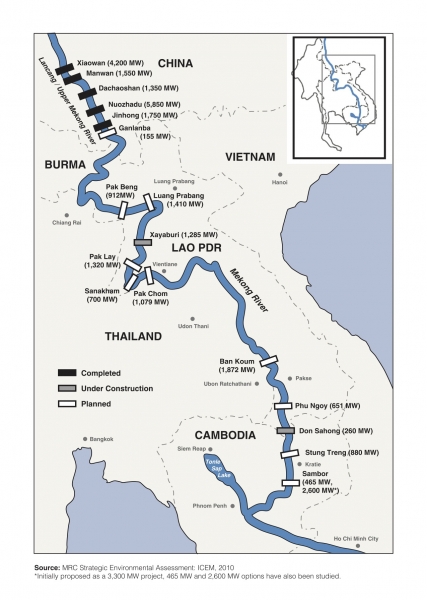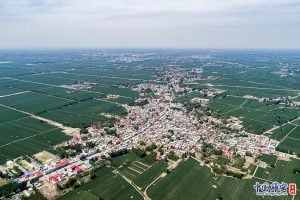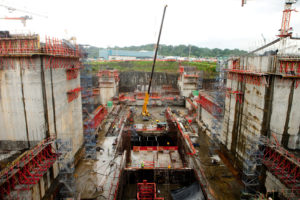In the Mekong river basin, massive infrastructure projects – dams, road, high-speed rail and ports – are under construction. While these projects will improve connectivity between countries, harmful environmental impacts need to be minimised. National level environmental impacts assessments that ignore cross border impacts are likely to create conflict between countries, thus undermining the objective of improved connectivity.
This is why countries need to come together to develop a framework to assess the transboundary environmental impacts of projects in the river basin.
The Mekong River flows over 4,900 kilometres through six countries: China, Myanmar, Thailand, Lao PDR, Cambodia and Vietnam, with the upper portion of the river in China called the Lancang River. The lower basin supports a population of 65 million, many of whom are dependent on the river for fish and water for irrigated rice. Increasingly, the river has been tapped for its enormous hydropower resources, as well as for river transportation of bulk goods, mainly from China.
The Mekong River basin is suffering multiple threats. Hydropower dams are changing river flow, blocking fish passage, reducing sediment flows, eliminating river bank gardens, exacerbating biodiversity loss, polluting the water, and potentially creating conflict between countries.
There are also massive infrastructure development plans (estimated at USD 63.5 billion by 2022) under the Greater Mekong Subregion Economic Program. Highways, bridges, ports and river transport, high speed railways, duty free and economic concession zones, tourism development, and associated urban development, are all aimed at increasing connectivity and economic growth among the Mekong countries. Add to this the increasingly urgent threat of climate change which is already contributing to saltwater intrusion in the delta, increased flooding in the wet season, longer drought periods, and reduced agricultural production.

Climate change impacts are projected to cause damage as high as USD 565 million per year, with particularly disastrous impacts on the Tonle Sap Lake ecosystem in Cambodia, one of the most productive fisheries in the world.
The growth of smuggling, human trafficking, wildlife crime, drugs, illegal logging, and transboundary air and water pollution are all creating wider social problems.
See: Mekong through photographers’ eyes: “disaster after disaster”
Focus on hydropower
To analyse just one of these threats, China has already built at least six dams on the Lancang River, with around 14 additional dams to be built over the next decade. There are 11 dams planned for the mainstream in the lower basin by 2030, despite a 10-year moratorium on mainstream dams recommended by the Mekong River Commission (MRC) – the intergovernmental body responsible for coordinating management of the lower part of the river. These dams will produce 65,000 GWh of electricity, or 6-8% of forecasted power demand. In addition, there are 30 dams planned on the tributaries which would produce an additional 44,000 GWh. Total capital investment is projected to be about USD 50 billion.
The three highly controversial mainstream dams that are currently underway are Xayaburi, Don Sahong, and Pak Beng, all in Laos. Laos has recently notified the MRC of its plans to build a fourth dam at Pak Lay. The construction of the Xayaburi dam, with an installed capacity of 1,260 MW, started in 2012 and is expected to be operating in 2019. Don Sahong will produce 260 MW of electricity and is located on one of the braided channels in the Mekong’s Siphandone area in southern Laos. Construction started in 2016. The latest dam site is Pak Beng 174 kilometres upstream of Luang Prabang, with an installed capacity of 912 MW. Clearly, all of these dams will have transboundary environmental impacts, with the downstream areas most at risk, including the delta in Viet Nam and Tonle Sap Lake in Cambodia.
Unfortunately, none of the Mekong countries have any formal requirement for transboundary environmental impact assessments. All Mekong countries have adopted laws requiring environmental impact assessments (EIAs) for development projects with potentially significant impacts.
However, many EIAs in the lower Mekong countries are of poor quality and their governments have very limited technical capacity to review them. Mekong countries are also gradually introducing strategic environmental assessments (SEAs) for plans and programs (generally not for policies). SEAs look at cumulative impacts, whereas EIAs look only at the impacts of a specific project.
See: Thai energy review could lead to suspension of Mekong dam
Legal obligations
Under international law all countries have an obligation to “undertake an EIA where there is a risk that the proposed project may have a significant adverse impact in a transboundary context, in particular, on a shared resource.” The International Court of Justice (ICJ) has recognised that this principle extends to the need for EIA processes to engage with affected neighbouring countries.
In 1987 a Group of Experts from UN Economic Commission for Europe elaborated on EIAs in a transboundary context (TbEIA). The Convention of Environmental Impact Assessment in a Transboundary Context (Espoo Convention) was negotiated from 1988 to 1990 and entered into force on September 10, 1997. At present there are 44 parties to the Espoo Convention, including members of the European Union, the Russian Federation, and the United States. However none of the Mekong countries are members of the Convention.
Under the Mekong River Commission’s 1995 Mekong Agreement member countries are required to give prior consultation for activities on the mainstream of the river. This was further enhanced by the Procedures for Notification, Prior Consultation and Agreement (PNPCA) adopted in 2003. The aim was to provide other member countries with prior notification of any mainstream development that would likely have a transboundary impact.
Several attempts have been made by the Mekong River Commission (MRC) to advance the idea of a more comprehensive, formal TbEIA framework. The initial draft was drawn up by 2006. In 2009, the Environmental Law Institute assessed the EIA/SEA proposed framework in the context of global best practice and provided a revised draft framework. The MRC has remained committed to the implementation of a TbEIA framework and successive CEOs have said that it is still under active consideration. But there has been no progress because the countries involved can’t reach a consensus.
Time running out for the Mekong
Returning to the latest mainstream dam, the Pak Beng EIA, the Lao EIA Decree, and the 2015 Policy on Sustainable Hydropower all recognise the need for an assessment of the transboundary and cumulative impacts. A Transboundary EIA and Cumulative Impact Assessment Final Report (dated May 2015) was prepared by a consultant for the project developer China’s Datang Power Company.
An independent review of this document by the International Rivers Network found that the “TbEIA Report 2015 does not enable an accurate assessment of the potential environmental and social impacts of the Pak Beng Project on downstream countries and communities,” and recommended that a new EIA be undertaken.
Accordingly, even when transboundary impacts are considered, the level of assessment is inadequate, strengthening the case for a more formal TbEIA protocol or equivalent amendment to the MRC Agreement.
Alternatively, the matter could be elevated to the ASEAN level, as all lower Mekong countries are ASEAN members. However, other considerations will likely mean that all the planned mainstream dams are likely to be completed before such a protocol is adopted.
Nevertheless, as infrastructure development will continue for many decades, a formal TbEIA agreement is still worth pursuing.
![<p>Aerial view of the Mekong Delta often referred to as the rice bowl of Vietnam [image by: Gareth Bright]</p>](https://dialogue.earth/content/uploads/2018/02/Vietnam1.jpg)



![Students of Presentation Convent School Peshawar look at stuffed wild species displayed during their visit to the Wildlife Department of Khyber Pakhtukhwa as part of awareness raising field tour [image by: Adeel Saeed]](https://dialogue.earth/content/uploads/2018/07/Students-at-wildlife-stall-in-abbottabad-300x200.jpg)


![Under Narendra Modi, there has been a renewed focus on building large dams and diverting rivers [Photo shows the Brahmaptura by: INDIA-ACTED-SAMISIVA-130]](https://dialogue.earth/content/uploads/2017/11/37440237726_e8fd1aa6d6_k-300x199.jpg)
